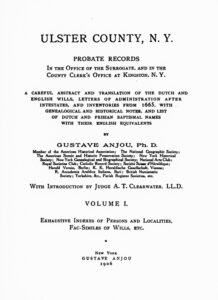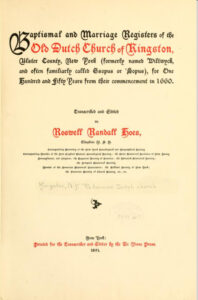Esopus / Wiltwyck / Kingston, New York
This post covers a bit of Kingston, New York early history. Esopus, New Netherlands settlement was the third established by Dutch settlers. The first two: New Amsterdam (Manhattan) and Beverwyck (Albany). Although the area of Esopus encompassed what is now the current Ulster County, many documents I found refer to the current Kingston, New York as Esopus before 1661, and Wiltwyck from 1661 until the English renamed it, and for a short time Swaenenburgh. Wiltwick (with a variety of spellings) is prominent in many of the early documents.
Table of Contents
Kingston, New York Name History
This is where Jan Joosten van Meteren and family settled when they arrived in America. They would land in New Amsterdam and then take a ferry up the Hudson River to this new community on the Hudson River.
- About 1652 – 1661: Referred to as Esopus in New Netherlands and called Sopus by locals.
- May 16, 1661: Officially becomes a village – Wiltwyck (aka Wiltwijk, Wildwyck), New Netherlands
- Sept 1664: New Netherlands becomes an English Colony, and named New York
- 1669: Wiltwyck is renamed Kingston
- 1673 – 1674: Dutch take control and Kingston becomes Swaenenburgh, Manhattan changed to Niew Oranje, and New York Colony is changed back to New Netherlands.
- 1675: becomes Kingston, New York again
- 1683: Ulster County established
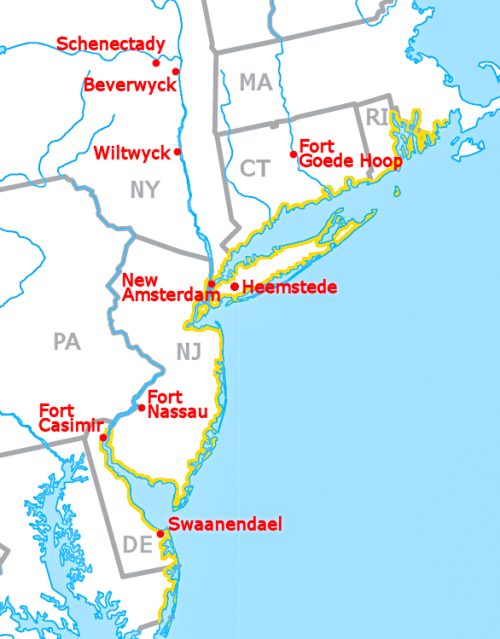
Map showing the area claimed by the Dutch in North America and several Dutch settlements.1
Kingston, New York - Ulster County and Church Records
Many of the The Kingston, New York Records, The Ulster County, New York Probate Records and the Old Dutch Church Baptism and Marriage Records, written in Dutch, have been preserved, for the most part, translated, transcribed and eventually available online. These records provided more information and details about the lives of our immigrant ancestors even more clearly than I was able to find in later generations. These records provide record of marriages, births, property transactions and legal disputes, which give us “The picture of life in the village”.
In the Kingston New York Records, the minute’s show at first a primitive state of affairs, but gradually present a more organized aspect. We read first of complaints of shortage in the food supply for the military, and of clashes between the soldiers and some of the inhabitants.
Then comes the sad case of Grietjen Westercamp and her efforts to establish the paternity of her child. Later, after the inauguration of the second Indian war in 1663, we read of Aeltje Sybrants, the wife of the gunner Matthys Roelofsen, and her contemptuous treatment of the order of the council of war forbidding the sale of strong drink to the troops or to the Indians, and of the proceedings to punish her for contempt.
Suits for slander also appear. One man felt aggrieved because he was called a Jew, another because he was called deceitful, and another because he was called a little tattletale. One litigant railed at the court after losing his case and called one of the judges, who was a physician, a bloodsucker, and was brought to the bar to apologize.
Suits were frequent for the recovery of money due for wages, goods sold and money loaned. Mortgages and deeds were put on record. Lots for building purposes were granted by the court to various applicants. Various orders are entered for the regulation of affairs in the village.
Appeals are noted in several cases to the director general and council in New Amsterdam. Stuyvesant (director general) himself appears as a suitor for money, due from tenants and others. The Schout (local official), Swartwout, occasionally appears as a defendant, though usually as plaintiff to collect fines for violation of orders. His suits for the recovery of fines for violation of the ordinance forbidding any one to go out to mow without a convoy, are of interest as showing the strictness of the precautions to prevent further attacks by the Indians.
The troubles of Domine Blom, the first minister, in his efforts to collect his salary, in arrears for several years, are reflected in suits against several of the inhabitants who had agreed to pay their share but had neglected to do so. Suits relating to the parsonage then being erected are several times mentioned. The domine’s dispute with the magistrates regarding the administration of the estates of several intestates, as to which the church claimed an ecclesiastical right, is the subject of various entries. In one of these the domine takes occasion to rebuke the court for writing to him a business letter dated on a Sunday. In his reply, he expresses his astonishment that they should work on that day, seeing, as he said, that there were enough other days in the week, and he adds that this no doubt is the reason why the magistrates’ pew is empty during the Sunday morning and afternoon services. His anxiety for the welfare of the community is shown in a long letter in which he asks the magistrates to co-operate with him to suppress the celebration of Fastenseen (Shrove Tuesday or Mardi Gras), as being of pagan origin and conductive to bacchanalian orgies. The Court gave the necessary order.
The name of the village appears as Wildwyck in the translated Kingston New York Records, instead of Wiltwyck, which the author of The History of Ulster County, N.Y.26 uses. The editor adds that the new name was given in honor of the Indians who had made a ‘free gift ‘of the soil, and that the Governor probably meant it to be known as Indian retreat, Indian Refuge or Indian Village. Although most records spell it Wiltwyck which may have a different translation. Records change to Kingston from 1671 on, except during the Dutch re-occupation in 1673-74, when the name Swanenburgh was given to it.
Director General - Petrus Stuyvesant
The Dutch Esopus / Wiltwyck / Kingston Memories5 by Theodore Dietz provides an excellent outline of the living conditions and early interaction with the Indians in Esopus that will directly impact the ancestors:
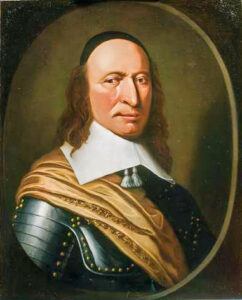
On May 11, 1647, the new Director General, Governor of New Amsterdam, Petrus (Pieter or Peter) Stuyvesant, arrived on the ship Groote Gerrit (Great Cow).[photo of his portrait to the right]
Up until 1658, Esopus was a sparsely settled place on the Esopus creek about a hundred miles north of New Amsterdam (New York) and about fifty miles south of Fort Orange (Albany), destined to become the city of Kingston. There was no village, the area was just referred to as Esopus. There were only Dutch, English, French, German, other European, and native American farmers, tradesmen, and laborers working to feed themselves and persons living in the larger area administered by the Dutch West India Company.
The farmland at Esopus had been cleared and farmed by American Indians for more than five hundred years before the Europeans arrived. The new farmers found the land to be extremely fertile. At first, all farmland was purchased from the Esopus natives, who were paid with trinkets, blankets, clothing, cooking utensils, firearms, ammunition, and alcohol.
Until 1658, Dutch and native farms at Esopus existed alongside one another, and disputes were developing between the two groups. Dutch farmers permitted their horses, cows, pigs and other livestock to roam freely through the fields; native maize [a British name for corn] was eaten by the animals or trampled under their hooves.
A greater danger developed for European settlers as the Esopus tribe threatened to set fire to the colonists’ thatched cane roofs and wood houses if the settlers did not provide a gratuitous spring plowing of native fields. Fire was a real threat, particularly with flimsy wood huts heated by an open fireplace and having chimneys molded of twigs and mud. (The twig and mud chimneys were prohibited by Stuyvesant in 1661, and later chimneys had to be built of stone or brick).
European farmers reported their “Indian problems” to Director Stuyvesant, and he traveled to Esopus to meet with Indians and settlers on May 29, 1658. He told the farmers they had to remove their homes from the farmland and rebuild them inside a stockade enclosed area where they could exclude an enemy; they could defend one another, and a few soldiers could provide security.
The Governor then met with about fifty Esopus Indians on May 30, 1658 and explained that they had to stop killing and injuring settlers and livestock and should sell the remainder of Esopus farmland to him so as to exclude native farmers from any contact with, and thus conflict, with the Dutch. He also told them they must compensate all injured parties for killing and wounding people and farm animals.
Slavery in the North
Yes, some of the ancestors did own slaves. This is evident in documents, such as Tesstamentary Dispositions and Wills. There were also other servants, whether they were owned or indentured was not always clear.
The following is an excerpt from Slavery in the North6website that was of interest regarding slavery in New Netherlands:
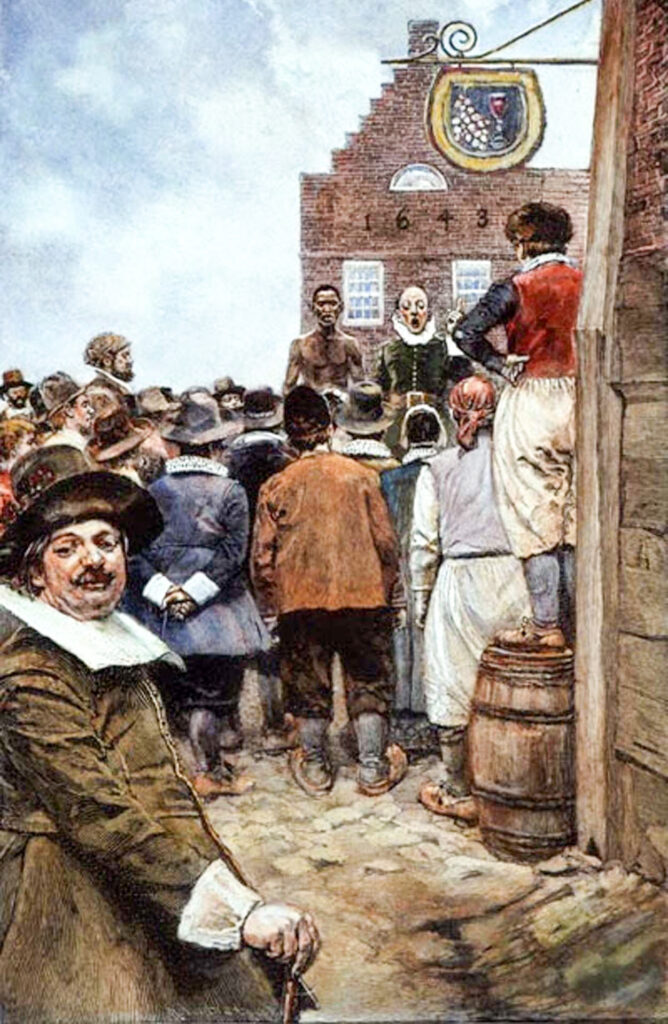
Use of black slaves in New Netherlands began in 1626 when the first cargo of 11 Africans was unloaded by the Dutch West India Company. The company had been founded in 1621, and it operated both as a commercial company and as a military institution with quasi-state like powers. From the 1630s to 1650s, the company was the dominant European slave trader in Africa. The company imported slaves to new Netherlands to clear the forests, lay roads, build houses and public buildings, and grow food. It was company-owned slave labor that laid the foundations of modern New York, built its fortifications, and made agriculture flourish in the colony so that later white immigrants had an incentive to turn from fur trapping to farming.
The purely economic status of slaves in New Netherlands contrasted with the malignant and sometimes bizarre racism of the religious British citizens who followed the Dutch into the north Atlantic colonies. Free blacks in New Netherlands were trusted to serve in the militias, and slaves, given arms, helped to defend the settlement during the desperate Indian war of 1641-44. Blacks and whites had co-equal standing in the colonial courts, and free blacks were allowed to own property ( Jews, however, were not). They intermarried freely with whites and in some cases owned white indentured servants.
Slaves who had worked diligently for the company for a certain length of time were granted a “half- freedom” that allowed them liberty in exchange for an annual tribute to the company and a promise to work at certain times on company projects such as fortifications or public works. Individual slave owners, such as Director General Peter Stuyvesant, adopted this system as well, and it enabled them to be free of the cost and nuisance of owning slaves year-round that they could only use in certain seasons. For the slaves, half-freedom was better than none at all.
Once the British took over in 1664, and control of the colony passed to the Duke of York, who, with his cronies, held controlling interest in the Royal African Company. The change of name from New Netherlands to New York brought a crucial shift in policy. Whereas the Dutch had used slavery as a part of their colonial policy, the British used the colony as a market for slaves.
Manumissions
Many of our ancestors owned slaves. Some of these slaves were mentioned in wills as property being willed to others. Some of our ancestors willed them personal possessions as a sign of appreciation. In some cases it included a letter of manumission, freeing the slave after their death.
The Stockade
In 1658 Peter Stuyvesant selected a site for the stockade on a plateau, about twenty-five feet above the farmland which bordered to the north. The area chosen was about 1300 feet by 1200 feet. It was protected on the north, east and west by steep slopes and on the south, there was flat level ground. There was a brook (Tannery Brook) running along the base of the west slope toward and eventually emptying into, the Esopus creek. With the stockade on all four sides, the hill on three sides, and a stream to the west, it became a very defendable location for the settler’s homes.
In three weeks, the settlers built an abbreviated stockade which was located within today’s North Front Street, Clinton Avenue (East Front Street), John Street, and Wall Street (Dwaar Street). Logs were cut from the forested plateau as the place was cleared for homes. The stockade logs, eight to twelve inches in diameter and eighteen feet in length, were stood on end alongside one another and buried four feet in the ground. The completed stockade rose fourteen feet above the ground.7
Accurate descriptions of Kingston’s original stockade, built between 1658 and 1677, have eluded historians for centuries. And no wonder. The original “Miller map” of the area went to the bottom of the Atlantic Ocean after its creator’s ship was attacked by French privateers. The Rev. John Miller, who survived capture, later re-created the map from memory. According to Theodore Dietz, author of Kingston Stockade8, Miller was appointed in 1692 as chaplain to British forces in New York Territory.” One of the Anglican minister’s duties was mapping the several forts the British had established along the Hudson and Mohawk rivers after taking possession of the former Dutch colony in 1664. One of those forts was located in Kingston, said Dietz, “with six guns lined up on [what would become] Main Street.”
Miller, who held a doctorate in theology from Edinburgh University in Scotland, walked the streets and byways of the Kingston stockade and consulted recorded deeds in order to produce an accurate map.
Having completed his work, Miller sailed from New York Harbor in 1695. As his records contained “ticklish information about guns and such,” Miller, for security reasons, threw everything overboard when the French attacked. After being released, Miller journeyed to London, where he reconstructed his records and maps from memory.Those records,filed in the Bishop of London’s archives,remained undiscovered in the British Museum until 1843.9
Following is Millers Map. I enhanced it a bit. to better display the numbers.
Fair Street and Wall Street did not exist in 1658-1689 and Dover Street was just an alley. John street wa just a dirt wagon track and was probably not named.10
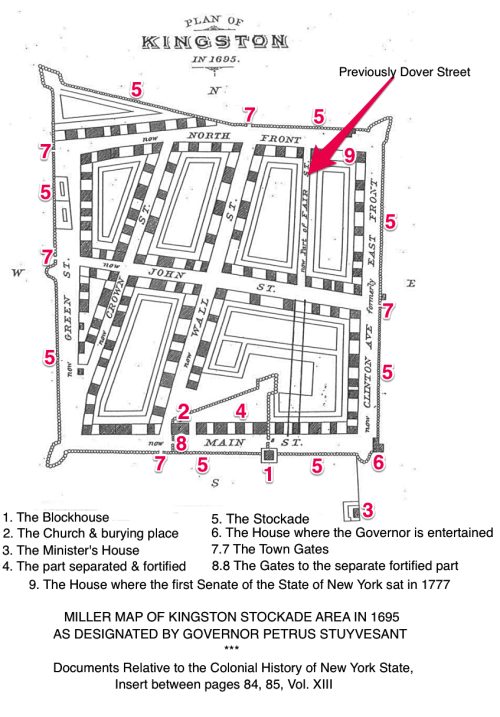
Edited Version of the Miller Map of Kingston Stockade Area in 1695.11
The figure below shows the stockade sections as they were added. 1658 stockade outlined in red contained sixteen assigned building lots and enough land for residents to grow garden vegetables for family use. There were about fifty settlers living in the stockade at that time, and more immigrants were arriving to take advantage of cheap farmland and considerable freedom. In 1661, it became necessary to extend the stockade west to include Green Street, outlined in green, and to provide an additional 32 building lots for the new arrivals. The stockade was extended to the south in 1670, outlined in blue and again in 1676 so the final southern wall included Main Street and the Old Dutch Church and burial ground, outlined in orange.
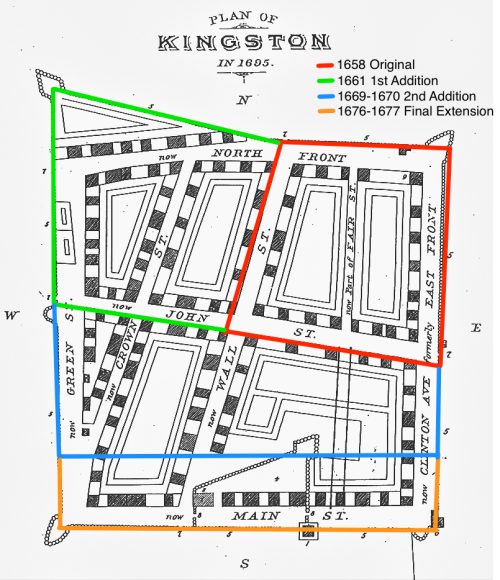
Inside the stockade, the settlers felt secure enough to construct sturdier, more permanent 20 ft. by 20 ft. homes. They excavated about six feet for the cellar with a dirt floor below the frost level where they could dig root crops (potatoes, carrots, beets, etc.) for winter use. The houses included a stone foundation with no mortar so that some moisture could penetrate and keep the stored vegetables from drying. Their houses were mostly one room wooden homes, for living, with storage for grain on the second floor. The houses were constructed using H Bent framing (it resembles a series of goalposts, two vertical posts and a cross beam) and weather-board siding. Wood for the houses was plentiful in the forest and tradesmen, after damming up Tannery Brook to form a millpond, erected a grist mill and a saw mill at North Front Street.12
The Esopus natives donated the land for the stockade to Governor Stuyvesant and agreed to sell him additional farmland to avoid future disputes.
Living Conditions
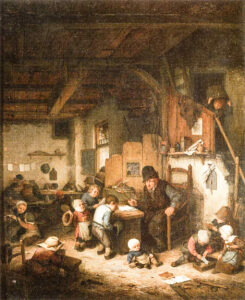
By the time the children reached the age of seven, children were expected to help at home by doing chores. Often working side by side with their fathers, boys chopped wood for cooking and for heating the home. They also helped their fathers hunt and fish. Mothers taught their daughters how to cook, sew, and clean house. Hauling water and making sure they had clean drinking water were daily chores. Although they likely had cisterns to collect water, it was most likely not clean. Both boys and girls helped tend the family’s crops and livestock. Living quarters were tight, in one room 20 by 20 feet had minimal furniture. Cleanliness was a challenge and body odor a common problem. Bathing took place in streams or lakes, usually only in the warmer months.
Most families had to weave their own cloth for clothes and make their own candles. Cooking would have been done outdoors. Beds were made of straw, usually infested with critters. Fire in the fireplace was a hazard, as the house was made of wood and the roof of dry straw. And, of course there was no indoor plumbing. Placement of the outhouse was important. You didn’t want it too close for obvious reasons, but not too far, either.
Babies were born in homes. Dutch settlers celebrated the birth of their children, but many of their children never made it to adulthood. Injuries and diseases—even chest colds—were deadlier then. Children were also more likely to lose a parent than we are today. It was common for settlers’ children to grow up in mixed families with step-families. Some became orphans.13
Water for drinking and cooking had to be hauled from a stream, a rain barrel, cistern or a well. Every house had a rain barrel under the eaves, and often a cistern. Because water from cisterns was often muddy and clean water more difficult to get, colonists often drank beer, wine and brandy which were usually home brewed but also available for purchase and were sometimes used in place of money.
Neighboring forests were uncut and could only be penetrated on Indian trails. The average European had no idea where those trails ended or how far they extended. There were dirt trails (primitive roads) in the farming areas but they were either dusty or muddy depending on weather. Those “roads” were rough and rutted from horse and wagon travel, not well maintained and not comfortable for walking.
Travel on the Hudson by sloop was faster and more comfortable, but it was expensive and not available after the river froze. Passengers were expected to bring their own bedding and their own food since a trip to Manhattan usually included at least one overnight and sometimes more. Horse and sleigh travel on the frozen Hudson River and over snow covered “roads” was pleasant and fast but it was only possible if you owned a horse and a sleigh.
Cleanliness was a problem where there were no indoor bathrooms and no indoor plumbing. Bathing, when it took place, was an event for the stream or the lake in warm weather. In the winter, everyone wore layers of clothing to keep warm and to cover up their body odors.14
Children were taught proper values and good manners. At school, students studied the Bible and memorized the teachings of the Dutch Reformed Church.
The Old Dutch Church
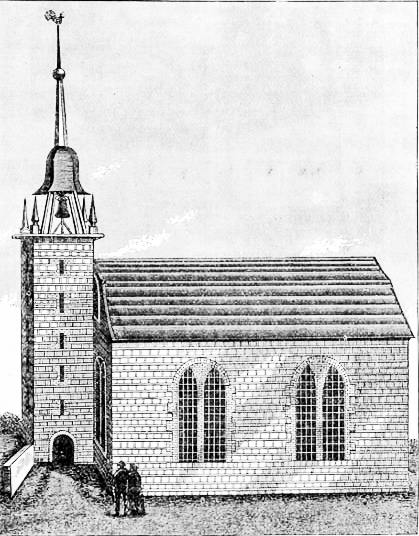
One of the first efforts was to establish a church. Like many churches, the Old Dutch Church began with informal meetings, in its case starting around May 1658. Jacob Stoll, a local settler, led service for 11 others in his house in the absence of an ordained minister or building.
On the request of by the villagers for a Domine [pastor] to help them establish a church in 1659, the Classis [church management] in Amsterdam sent Hermanus Blom, who gave two sermons and was offered the job. He returned to Amsterdam to complete religious studies, was ordained on February 16, 1660 and returned to Esopus in September. Meanwhile, the settlers, in 1659, formed the First Protestant Reformed Dutch Church of Esopus and patiently waited for Domine Blom’s return.
They did not have a physical church, but they had an organized church with members who met, at first in a private home, then in the Ministers House, which had been ordered to be built in 1660 by Peter Stuyvesant with money and building materials that were provided by the colonists.
Director Stuyvesant ordered the construction of a minister’s house, town house, which was also used as a church, school, court, and community meeting house. The four-room building with basement was completed in 1661 at a cost of 3,007.8 Florin. The bill (about $1200) was paid on November 21, 1661, after tax collector Jacob Burhans collected a property tax and a liquor tax from the residents. There was practically no money in circulation, so the settlers paid their debts using wampum, beaver skins, and grains or other farm products. Debtors prison, for those able to pay but not paying, was located in a room in the minister’s house.15
Sunday was a day of rest and everyone was expected to participate in church services. Two sermons were performed, one in the morning and one in the afternoon.
On May 16, 1661, Director General Peter Stuyvesant chartered the Village of Wiltwyck and enacted laws which supported the new church, such as:
- No person was to work on Sunday.
- No entertainment was allowed, no intoxication was allowed and the sale of alcohol was prohibited on Sunday.
- No one was to propose a religious dispute.
- Everyone had to respect and assist in family worship.
–
The domine’s house was used for worship until 1679, and was occupied during the ministry of Hermanus Blom, Peter Tessemaker, and Laurentius Van Gaaasbeek.
In 1679 a small stone building was built on the northeast corner of Wall and Main Streets. The church, 45 feet x 60 feet was built of local limestone and its walls were three to four feet thick. Here was kept by the successive dominies with rare fidelity and thoroughness, the records of marriages and baptisms.16
Wiltwyck 1664 - under English Rule
On August 27, 1664, four English frigates led by Richard Nicolis sailed to New Amsterdam’s harbor and demanded New Nertherlands surrender. They got no resistance because numerous citizens’ request had gone unheeded for protection by a suitable Dutch garrison against “the deplorable and tragic massacres” by the natives. See my post The Esopus Wars.
The wars have caused hard times in the little community. Although the English had arrived in New Amsterdam, the community of Wiltwyck is still struggling to manage affairs as usual. The following excerpts from the Dutch Records of Kingston are written during this time of change.17
Extraordinary Session, Saturday, October 18, 1664.
Present: Willem Beeckman, Schout; Gysbert van Imbrock, Jan Willemsen Hoochteylingh, Hendrick Jochemsen, Commissaries.
On the proposition made by the Honorable Schout what to do in case the English should approach our village of Wildwyck, it is resolved that, at the discharge of a cannon, all the burghery [citizens] shall repair to the head watch, there to receive further orders, and that in the meantime the Honorable Schout, together with the Honorable Court, shall seek to parley with said English beyond the gates. Meanwhile, the burgher officers are recommended to ascertain what powder and shot there are among the burgher, as we can not tell how the savages will act in these circumstances. Thus, done by the Schout and Commissaries at Wildwyck, the day and year above mentioned.
Extraordinary Session, Saturday, October 18, 1664.
Present: Willem Beekman, Schout; Thomas Chambers, Gysbert van Imroch, Jan Willemsen Hoochteylingh, Commissaries.
The Honorable Schout asks how the minister’s salary is to be paid.
It is resolved that the old and first book of the retired Commissaries be first made up, so as to show the situation to the newly appointed Commissaries. It is further resolved, that, in accordance with the previous order of the Honorable Director General, every resident householder shall, for each year of the past four years, contribute towards to minister’s salary one guilder for every morgen, and other inhabitants ten guilders, heavy money, in wheat, for every single lot at Wildwyck, the schepel to be reckoned at fifty stivers, and that the inhabitants shall be commanded herein to make payment within three weeks, on pain of [issuance of ] execution.
The Honorable Schout submits:
- That it is necessary to send some of the Honorable Judges to the Manhattans, to ask the Governor there a warrant of authority for the continuance of the Court here.
- Also, that the farming of the beer and wine excise be continued until the village debt, caused by the heavy wars, shall be paid.
- Further, that the delegates arrange with the Governor there with reference to the quartering of soldiers at Wildwyck.
- And further, that the delegates also ask for linen and blankets for the soldiers quartered here, who have made request therefor, as the inhabitants here are unable to provide them, therewith, because a great deal has been destroyed by the heavy war.
- Also, that, pursuant to the articles of peace concluded with them, the savages be not permitted to come or trade on this side of the Kill near the Redout, nor on the lands about the village.
–
Upon the foregoing propositions, there are chosen from the Magistrates the Honorable Officer, Willem Beeckman, and Schepen, Jan Willemsen Hoochteylingh, who are herewith commissioned and authorized to promote the said propositions with the Governor at New York, as they are considered necessary for this place.
Ordinance forbidding trade with the savages on this side of the Kill near the Redout.
Whereas, the Honorable Court at Wildwyck has been informed that some of the residents here have attempted to sell to, or buy from, the savages, meats or other merchandise on this side of the Kill near the Redoubt, by which acts the savages have been encouraged to show themselves in and near the village and dwelling houses here, in violation of the wholesome articles of peace, the Honorable Court, therefore, in order to guard against any calamity, hereby prohibits anyone here to attempt to trade with the savages on this side of the above named Kill, under a penalty of one hundred guilders for the first offense, double for the second, and arbitrary punishment for the third, one-third of the above stated fine to go to the informer. Thus, enacted at a meeting of Schout and Schepens of the village of Wildwyck, this October 18, 1664.
Ordinary Session, Tuesday, October 21, 1664.
Present: Willem Beeckman, Schout; Thomas Chambers, Gysbert van Imbroch, Jan Willemsen Hoodhteylingh, Commissaries.
Whereas, the old retired commissaries have several times been admonished to liquidate the village accounts, they are therefore hereby again ordered and directed either to do so, or to have the same done, within eight days, under penalty of fifty guilders.
Whereas, the Honorable Schout and Schepens of the village of Wildwyck feel concerned over the delay in making up the village accounts, they are therefore hereby again ordered and directed to either to do so, or to have the same done, within eight days, under penalty of fifty guilders.
Whereas, the Honorable Schout and Schepens of the village of Wildwyck feel concerned over the delay in making up the village accounts, and understand the Roelof Swarwout, retired Schout, is negligent in giving up papers, and information relative thereto, said Roelof Swarwout, is therefore ordered to immediately to deliver up all such account papers and documents relating to the village of Wildwyck, and, with the old Commissaries, report to the secretary, to make up the old accounts of the village.
Honorable Mr. Beeckman.
Whereas, the Commissaries understand that your Honor has been ordered to send to the Manhattans the powder and shot belonging to the Honorable Company still here, we, the Commissaries, therefore, deeming its necessary to the welfare of the village, request that your Honor be pleased to leave the packages of powder and shot here, until the English Governor at the Manhattans shall have sent us other packages of powder and shot, because, among the congregation or inhabitants here, no powder or shot can be found or procured, so that, in case of unexpected danger from the savages, the inhabitants may be provided therewith. Awaiting your Honor’s written and immediate reply.
Extraordinary Session, Friday, November 14, 1664.
The Officer, Willem Beeckman, reported to the Honorable Court what had been accomplished by him and the Commissary.
Jan Willenisen Hoochteylingh, at the Manhattans, with the Governor General, and thereover showed the Court a Warrant given him by the aforesaid Governor. The Honorable Court thereupon resolved to publish said Warrant to the community, which, translated from English into Dutch, reads as follows:—
Regarding the welfare and the tranquility of matters in the Esopus, the following instructions are hereby ordered to be published and observed:
- That the present officers and Schepens shall on all occasions, as heretofore, be obeyed as authorities, until the contrary appears over my signature.
- That the minister’s arrears be promptly paid, and he shall continue his service as heretofore.
- That no one shall sell brandy or liquor to the savages, under penalty of five hundred guilders.
- That the Indians or savages shall be permitted to peacefully enter the Esopus or the village of Wildwyck during the day time, to sell venison and other merchandise, and that no evil or injury be done them, because I have agreed with the Sachems, for themselves as well as for their subjects, that no injury or violence shall be done to the subjects that no injury or violence shall be done to the subjects of his Majesty of England.
- That the soldiers shall be quartered by the Magistrates in the houses of the inhabitants, to whom I shall give good pay, to be fixed by agreement.
- That the inhabitants and the soldiers shall dwell together in amity and friendship, so that, in occasions or time of need, they may act together as one man.
- In case any difference should occur between a soldier and an inhabitant, the same shall, after complaint to the officers or Magistrates, be settled and decided by the officers and Magistrates alone.
–
Given over my signature, October 26, Old Style, 1664, at Fort James, in New York (Signed) Richard Nicola [Nicolls]
Wiltwyck officially changes to Kingston 1669
In 1669 Wiltwyck, now under English rule, was officially changed to Kingston.
Sidenote: Kingston became New York’s first capital in 1777 and was burned by the British on October 13, 1777, after the Battles of Saratoga. In the 19th century the city became an important transport hub after the discovery of natural cement in the region, and had both railroad and canal connections.
After the horrors of fire after the Second Esopus War, the wealthiest among the villagers began constructing homes and official buildings of stone and brick with tile roofs. The Senate House was completed in 1667, a stone church was completed in 1679 and the court house was built in 1683. Private wooden homes were being replaced by stone as the owners were able to raise enough money to cover construction costs.
The stone used in their new buildings was the gray limestone that existed just below the surface of most of Ulster County. The colonists did not have to look far or to dig deep. The stone is visible above ground today wherever a highway cuts through a hill.
A mortar used in stone construction was obtained from oyster shells that were ground into a powder and mixed with water. This oyster /water mortar was hard and durable and the shells were plentiful along the shore of the Hudson. Indians had been gathering oysters, as a food, in the Hudson River south of Poughkeepsie for centuries. It’s interesting that Manhattan Indians harvested oysters from the East River discarding empty shells along the shore. Manhattan’s Dutch settlers found pearls among the shells and the street along the west shore of the East River is now called Pearl street.
The Senate House, located on the west side of Clinton Avenue (East Front Street) just south of North Front Street is the oldest public building in the United States, and is the best-known attraction within the stockade. It is an old stone farmhouse built about 1676 by Wessel TenBroeck (1636-1704).18
Kingston becomes Swaenenburgh in 1673
In July 1673, during the Third Anglo-Dutch War, the Dutch quickly retook the colony of New Netherland, which the English called “New York”, with a combined fleet of a squadron of ships from Amsterdam and a squadron of ships from Zeeland, totalling 21 ships led by Vice Admiral Cornelius Evertsen and Commodore Jacob Binckes, then the largest ever seen in America.. This was again a peaceful takeover with no blood shed.
They named Anthony Colve as governor and renamed the city of New York, New Orange after William of Orange as Stadholder of Holland in 1672; he became King William III of England in 1689. Kingston became Swaenenburgh, and Albany became Beverwijck. New York Colony becomes New Netherlands.
Swaenenburgh becomes Kingston again in 1674
The Treaty of Westminster in November 1674 concluded the Third Anglo Dutch War (1672-1674) and ceded New Netherland to the English and Suriname become a Dutch colony.
Once again, New Orange becomes New York City, Swaenenburgh becomes Kingston and Beverwijck becomes Albany. New Netherlands becomes New York Colony.
Citations and Attributes:
- Map showing the area claimed by the Dutch in North America and several Dlutch settlements. By Dedden 11:31, 30 April 2006 (UTC) - Own work, Public Domain, https://commons.wikime- dia.org/w/index.php?curid=744962
- The Dutch Records of Kingston, Ulster County, New York: (Esopus, Wildwyck, Swanenburgh, Kingston) 1658-1684, with Some Later Dates .... United States: n.p., 1912. Available free at Google Books: https://www.google.com/books/edition/The_Dutch_Records_of_Kingston_Ulster_Cou/L0U-AAAAYAAJ?hl=en (Accessed 22 Feb 2023)
- Ulster County, N.Y. Probate Records in the Office of the Surrogate, and in the County Clerk's Office at Kingston, N.Y.: A Careful Abstract and Translation After Intestates, and Inventories from L665, with Genealogical and Historical Notes, and List of Dutch and Frisian Baptismal Names with Their English Equivalents. United States: Anjou, 1906. Available free at Google Books: https://www.google.com/books/edition/Ulster_County_N_Y_Probate_Records_in_the/l_cLAAAAYAAJ?hl=en (Accessed 22 Feb 2023).
- Baptismal and Marriage Registers of the Old Dutch Church ofKingston, Ulster County, New York (formerly named Wiltwyck, and often familiarly called Esopus or “Sopus), for One Hundred and Fifty Years from their commencement in 1660. Transcribed and Edited by Roswell Randall Hoes, Chaplain U.S.N.1891.Available free at Archive.net: https://archive.org/details/baptismalmarriag00king/page/n7/mode/2up (Accessed 22 Feb 2023).
- Theodore Dietz, Dutch Esopus / Wiltwyck / Kingston Memories, 2012
- Douglas Harper, Slavery in the North website (Accessed 22 Feb 2023)
- Theodore Dietz, Dutch Esopus / Wiltwyck / Kingston Memories, 2012.
- Theodore Dietz, Dutch Esopus / Wiltwyck / Kingston Memories, 2012
- Hugh Reynolds, hv1 website When there was a wall: Kingston's stockade, 07 July 2014. (Accessed 22 Feb 2023).
- Ted Dietz, Kingston, New York, Remembered, undated
- Edited Veersion of the Miller Map of Kingston Stockade Area in 1695. The Old Dutch Church website. http://jwwerner.com/ODC/OldDutchChurch.html (Accessed 22 Feb 2023)
- Theodore Dietz, Dutch Esopus / Wiltwyck / Kingston Memories, 2012
- New Netherland Institute Website - Exploring America's Dutch Heritage, History and Herittage.
- Ted Dietz, Kingston's Stockade, some thoughts on a Dutch Village and its people, 2009
- Theodore Dietz, Dutch Esopus / Wiltwyck / Kingston Memories, 2012.
- Baptismal and Marriage Registers of the Old Dutch Church of Kingston, Ulster County, New York 1660-1809. Available Online at https://archive.org/details/baptismalmarriag00king/page/n7/mode/2up (Accessed 23 Feb 2023).
- The Dutch Records of Kingston, Ulster County, New York (Esopus, Wildwyck, Swanenburch, Kingston) 1638-1684. New York State Historical Association, 1912, Book I, Part of Book II
- Ted Dietz, Kingston's Stockade, some thoughts on a Dutch village and its people, p 13. 2009.
- Portrait of Peter Stuyvesant. By unknown painter (attributed to Hendrick Couturier, in the past was considered a Rembrandt) – image source, Public Domain, https://commons.wikimedia. org/w/index.php?curid=214184
- The First Slave Auction at New Amsterdam in 1655, by Howard Pyle.By – [1], Public Domain, https://commons.wikimedia.org/w/index.php?curid=38796788
- The School Master, 1662. By Adriaen van Ostade – Web Gallery of Art: Image Info about artwork, Public Domain, https://commons.wikimedia.org/w/index.php?curid=15417123(Accessed 23 Feb 2023]
- Old Dutch Church-Print of Original (1679-1752, Kingston, NY, USA-By Unknown (Cropped and edited by Daniel Case 2009-07-29 – Here, Public Domain, https://commons.wikimedia.org/w/index.php?curid=7414515 (Accessed 23 Feb 2023).


